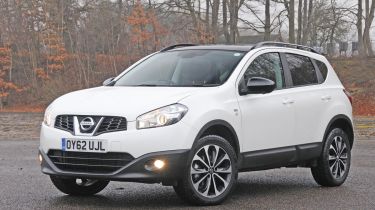Nissan Qashqai 1.6 dCi Visia
The Nissan Qashqai is the sensible option, but it could struggle to match newer rivals’ style
The Nissan is a little too conservative for this test. Apart from the sparkling dCi engine, it failed to shine in any area. It’s still solid family transport, but for no-frills everyday motoring, we’d go for the cheaper £18,295 1.5 dCi model.
The Qashqai is the most popular car Nissan has ever built. In just five years, the company has sold over a million examples. But it seems like the odd one out here – not least because the chunky proportions make it look like a model from the class above its rivals.
Appearances can be deceptive, though: the Qashqai is actually lower and narrower than the 500L, despite being considerably longer. The car in our pictures is a high-spec 360 model, but the Visia we tested comes with smaller 16-inch alloys and does without the smart black roof rails and rear privacy glass.
Unlike the Fiat and the MINI, there are few ways to jazz up the Nissan’s exterior to give it greater visual appeal – the rigid specification structure means there are almost no options for the entry-level car. If you want more kit, you have to upgrade to a more expensive trim.
This utilitarian philosophy is carried over to the interior, which feels tired and dated next to the Fiat’s characterful cabin. Swathes of dull grey plastic make it seem dreary inside and while the centre console is logically laid out, major touch points like the gearknob and steering wheel aren’t as pleasant to use.
Used - available now

2022 Nissan
Qashqai
20,000 milesAutomaticPetrol1.3L
Cash £22,785
2018 Nissan
Qashqai
55,085 milesAutomaticPetrol1.3L
Cash £14,087
2022 Nissan
Qashqai
39,385 milesManualPetrol1.3L
Cash £14,197
2022 Nissan
Qashqai
31,318 milesManualPetrol1.3L
Cash £16,697Standard equipment on Visia models is limited: you get Bluetooth and air-con, but to match even half of the 500L’s kit, you need to spend an extra £1,400 for an Acenta-spec car.
Put its spartan appearance aside, though, and the Nissan is undeniably very practical. There’s enough space for five adults to sit in comfort and the doors open wide, making it easy for passengers of any age to climb in. The seats are also more supportive than the MINI’s, while the Qashqai has the longest wheelbase here, along with a 410-litre boot that’s wide enough to swallow big suitcases.
Although the Nissan has fewer clever family touches than the 500L and its seats are fixed in place, it would still make for a slightly more useable everyday runabout than the Countryman. On paper, the 1.6-litre diesel is also the most impressive engine here, thanks to its 128bhp power output.
A relative lack of grip meant the Qashqai couldn’t match the MINI off the line, but it feels more urgent in-gear and was over three seconds quicker than the Countryman from 50-70mph in sixth, with a time of 8.6 seconds.
It also proved just as quiet and refined as the 500L on the motorway, yet an extra 181kg and vague steering take a toll when cornering, making the Nissan feel less agile than the other two. The trade-off is a smooth ride, but the six-speed box felt notchy and awkward after the slick-shifting MINI and Fiat.
Away from the track, Nissan has a proven record for mechanical reliability. It generally performs well in our annual Driver Power satisfaction survey and placed fourth last year.
However, there are some other aspects of Qashqai ownership that are less appealing. It will depreciate much faster than the MINI and has to be serviced twice as often as the 500L, so it’s likely to cost more to run as well. These drawbacks could see the former class champ struggle to beat its stylish rivals here.







